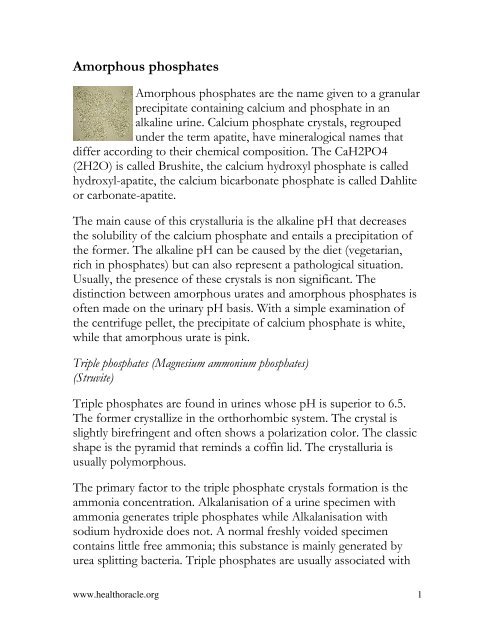Triple Phosphates crystals - Healthoracle.org
Triple Phosphates crystals - Healthoracle.org
Triple Phosphates crystals - Healthoracle.org
Create successful ePaper yourself
Turn your PDF publications into a flip-book with our unique Google optimized e-Paper software.
Amorphous phosphates<br />
Amorphous phosphates are the name given to a granular<br />
precipitate containing calcium and phosphate in an<br />
alkaline urine. Calcium phosphate <strong>crystals</strong>, regrouped<br />
under the term apatite, have mineralogical names that<br />
differ according to their chemical composition. The CaH2PO4<br />
(2H2O) is called Brushite, the calcium hydroxyl phosphate is called<br />
hydroxyl-apatite, the calcium bicarbonate phosphate is called Dahlite<br />
or carbonate-apatite.<br />
The main cause of this crystalluria is the alkaline pH that decreases<br />
the solubility of the calcium phosphate and entails a precipitation of<br />
the former. The alkaline pH can be caused by the diet (vegetarian,<br />
rich in phosphates) but can also represent a pathological situation.<br />
Usually, the presence of these <strong>crystals</strong> is non significant. The<br />
distinction between amorphous urates and amorphous phosphates is<br />
often made on the urinary pH basis. With a simple examination of<br />
the centrifuge pellet, the precipitate of calcium phosphate is white,<br />
while that amorphous urate is pink.<br />
<strong>Triple</strong> phosphates (Magnesium ammonium phosphates)<br />
(Struvite)<br />
<strong>Triple</strong> phosphates are found in urines whose pH is superior to 6.5.<br />
The former crystallize in the orthorhombic system. The crystal is<br />
slightly birefringent and often shows a polarization color. The classic<br />
shape is the pyramid that reminds a coffin lid. The crystalluria is<br />
usually polymorphous.<br />
The primary factor to the triple phosphate <strong>crystals</strong> formation is the<br />
ammonia concentration. Alkalanisation of a urine specimen with<br />
ammonia generates triple phosphates while Alkalanisation with<br />
sodium hydroxide does not. A normal freshly voided specimen<br />
contains little free ammonia; this substance is mainly generated by<br />
urea splitting bacteria. <strong>Triple</strong> phosphates are usually associated with<br />
www.healthoracle.<strong>org</strong> 1
acterial growth. With a first-morning fresh specimen, triple<br />
phosphates can indicate urinary tract infection. Otherwise, triple<br />
phosphates are of little clinical value.<br />
Clinical significance<br />
Except for the cystine <strong>crystals</strong> and a few others, the majority of<br />
<strong>crystals</strong> found in the urinary sediment are of limited clinical value. It<br />
is tempting to associate <strong>crystals</strong> with a risk of urolithiasis, but the<br />
majority of patients with a crystalluria does not have and will not<br />
develop kidney stones. Many benign situations can provoke crystal<br />
formation.<br />
In the majority of cases, the <strong>crystals</strong> found in urine are not present in<br />
the freshly voided specimen. Alkalization and refrigeration are<br />
promoters of <strong>crystals</strong> formation.<br />
Drug <strong>crystals</strong> are sometimes found in urine. In most cases, these<br />
findings are of little clinical value except, if the sediment’s picture<br />
indicates a possible renal obstruction. Crystal casts are<br />
pathognomonic of this situation.<br />
Some think that giving much time to the identification of unusual<br />
<strong>crystals</strong> is not worthwhile.<br />
Crystals related to urolithiasis are, except for cysteine, usual and easy<br />
to identify. Calcium is found in 80 to 95% of kidney stones, mostly as<br />
oxalate or phosphate <strong>crystals</strong>. Many stones are not homogeneous.<br />
Some have a nucleus of a different composition from the<br />
surrounding matrix. The following table shows stones composition<br />
listed by occurrence.<br />
Urolithiase composition and occurrence<br />
Type<br />
Calcium oxalate<br />
Whewellite (mono-hydrate)<br />
Weddellite (di-hydrate)<br />
Occurence in<br />
%<br />
70<br />
www.healthoracle.<strong>org</strong> 2
Calcium phosphate<br />
Hydroxyl-apatite<br />
Carbonate-apatite<br />
Calcium hydrogen phosphate (Brushite)<br />
Tri-calcium phosphate ( Whitlockite )<br />
<strong>Triple</strong> phosphates (Magnesium ammonium phosphate)<br />
(Struvite)<br />
www.healthoracle.<strong>org</strong> 3<br />
10<br />
5 to 10<br />
Uric acid
Urine is a supersaturated solution of calcium, phosphate and oxalate<br />
in equilibria.<br />
Crystal formation can be caused:<br />
• By an augmentation of concentration beyond the super-saturation capacity.<br />
This situation is mostly the result of a decreased dilution like in<br />
a case of insufficient water intake. The situation could also be<br />
caused by a high elimination.<br />
• By a decreased super-saturation capacity. This situation could be<br />
caused by a decrease in inhibitors concentration, a<br />
neutralization of these inhibitors, by some electrolytes, or a by<br />
pH change.<br />
• By the presence of <strong>crystals</strong> with a promoter effect on the crystallization of<br />
another species. Crystallization of calcium oxalate promoted by<br />
amorphous urates is a good example of this phenomenon. This<br />
situation is thought to be the result of a competition for the<br />
inhibitor site of Tamm-Horsfall protein. Urates and calcium<br />
oxalates adhering to mucus is a frequent observation.<br />
Some <strong>crystals</strong> are found exclusively in acid urine, others are found<br />
exclusively in alkaline urine.<br />
Amorphous <strong>crystals</strong> are often identified on the basis of the urine pH.<br />
In an acid specimen, urates are reported, in an alkaline specimen,<br />
amorphous phosphates are reported. This simplification should be<br />
used with care. Amorphous phosphates and triple phosphates are<br />
sometimes observed in slightly acid specimens. (pH 6.5)<br />
The usual <strong>crystals</strong> found in urine<br />
Alkaline pH<br />
Acid pH<br />
Amorphous phosphates<br />
<strong>Triple</strong> phosphates<br />
Ammonium biurates<br />
Calcium phosphates<br />
Calcium carbonates<br />
Amorphous urates<br />
Uric acid<br />
Calcium oxalates<br />
Cystine<br />
www.healthoracle.<strong>org</strong> 4
Specific clinical conditions that explain Urolithiase formation can also<br />
explain a persistent crystalluria.<br />
Hypercalciuria<br />
Increased urinary calcium elimination can result in a crystalluria,<br />
mostly as calcium oxalates. The superior limit for the calciuria is 75<br />
mmol/d under a 250 mmol/d diet.<br />
Hypercalciuria can be caused by:<br />
• an increase of the fraction of the diet absorbed.<br />
• a renal loss with a secondary increase in intestinal absorption.<br />
• an excessive bone resorption.<br />
• a primary hyperparathyroidia.<br />
• a combination of the previous causes.<br />
Hyperoxaluria<br />
Calcium oxalate is probably the crystal that one meets the most<br />
frequently in urinary sediment. In the majority of cases, the presence<br />
of these <strong>crystals</strong> is without any clinical meaning. According to<br />
Conyers, only 10 to 15% of the urinary oxalate is directly related to<br />
the diet. The majority of the urinary oxalates are produced by the<br />
metabolism (glyoxilic acid cycle). It seems that even light<br />
hyperoxaluria is, after the decreased urinary volume, the most<br />
significant factor in the recurrent calcium oxalate urolithiasis.<br />
In some cases, the crystallization of the calcium oxalate is massive<br />
and catastrophic. A typical example of the oxalate clinical catastrophe<br />
is the cases of ethylene glycol poisoning. In this situation, one can<br />
find oxalate <strong>crystals</strong> in the patient’s tissues. The toxicity syndrome<br />
affects <strong>org</strong>ans like the liver, the kidney, and the brain and is<br />
accompanied by a metabolic acidosis. Naturally, the oxalate<br />
crystalluria is massive, and is predominated by the ovoid <strong>crystals</strong><br />
(Whewellite) forming microlithes.<br />
www.healthoracle.<strong>org</strong> 5
Calcium oxalate casts are highly significant. These imply that the oxalate <strong>crystals</strong><br />
were already formed when the urine was at its maximum dilution.<br />
Conyers has reported other substances that can lead to oxalosis.<br />
Some of these substances are used as glucose substitutes in parental<br />
alimentation.<br />
Other causes of hyperoxaluria are:<br />
• Primary hyperoxaluria (a rare genetic disease).<br />
• Pyridoxine deficiency (vit B6).<br />
• Increased intestinal absorption of oxalates.<br />
Fatty acids are competing with oxalate for the intestinal calcium. In<br />
fat malabsorption, the increase of unabsorbed fatty acids mobilizes<br />
the calcium leaving the oxalate, free to be absorbed. Intestinal calcium<br />
limits the absorption of oxalate.<br />
Hyperuricosuria and calcium oxalates<br />
An increased elimination of urate is most frequently caused by a high<br />
purine diet. Over production, can also be a cause of hyperuricosuria.<br />
With a urinary pH greater than 5.5, amorphous urates will be the<br />
major crystal form. Below 5.5, uric acid <strong>crystals</strong> are observed.<br />
It is not rare to observe calcium oxalate <strong>crystals</strong> with amorphous<br />
urate in the same urinary sediment. Urate <strong>crystals</strong> seem to have an<br />
enhancer effect on the calcium oxalate crystal formation. A possible<br />
explanation is that urates and oxalates are competing for the lithoinhibitor<br />
macromolecules.<br />
Hypocitraturia<br />
The chelating effect of citrate is known to reduce the saturation in<br />
calcium salt. Also, the soluble chelating calcium complex seems to<br />
have an inhibiting effect on crystal formation. One can therefore<br />
expect an increase in <strong>crystals</strong> formation, and even urolithiasis in<br />
conditions leading to hypocitraturia.<br />
www.healthoracle.<strong>org</strong> 6
Hypocitraturia is seen in conditions like in:<br />
• Renal tubular acidosis, especially of the distal type. (RTA type I)<br />
• Chronic diarrhea.<br />
• Excessive animal protein intakes.<br />
Many bacteria infecting the urinary tract reduce the citrate<br />
concentration.<br />
5% of the hypocitraturia are of unknown causes.<br />
Uric acid<br />
Approximately 66 to 75% of the uric acid is eliminated by the urine.<br />
The quantity to eliminate depends mostly on the diet (meat). In<br />
increased uricosuria, values > 4.5 mmol/d are observed.<br />
Uric acid <strong>crystals</strong> are formed when the urinary pH is
the basic aminoacid: lysine, arginine, ornithine and cystine. This<br />
disease is called cystinuria. For a few patients with cystinuria, stones<br />
will develop. The urolithiasis is highly dependent of the urinary pH<br />
and water intake. Cystine is less soluble at a pH lower than 5.0<br />
(saturation 300 mg/l); saturation is of 500 mg/l at a pH of 7.4.<br />
Infection<br />
Infection with urea splitting bacteria (ex: proteus species) leads to a<br />
production of ammonia an alkalinization of the urine. The produced<br />
ammonia generates magnesium ammonium phosphate <strong>crystals</strong>, also<br />
called triple phosphates. The mineralogical name of triple phosphate<br />
is Struvite. <strong>Triple</strong> phosphates are usually found with amorphous<br />
phosphates, owing to their low solubility at alkaline pH.<br />
Crystalline structures<br />
Solid substances are divided in two large groups, amorphous<br />
substances and crystalline substances. Crystals have defined<br />
geometrical shapes while amorphous substances have not. More,<br />
<strong>crystals</strong> have a precise melting point, while amorphous substances<br />
have a melting point that spreads over an interval of temperature. In<br />
crystallography, one speaks of planes, axes, and angles to describe<br />
their shape. Crystals, while preserving their primary shape, have a<br />
very variable size, but the ratios and angles between the faces and<br />
between the sides, are constant.<br />
www.healthoracle.<strong>org</strong> 8
www.healthoracle.<strong>org</strong> 9











